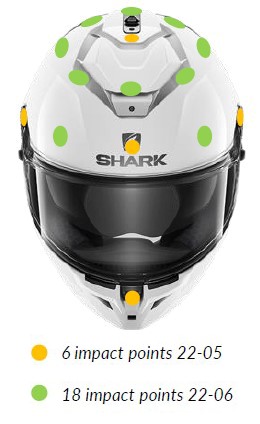ECE 22.05 or ECE 22.06?
Every motorcycle helmet sold in Europe needs to comply with a number of safety requirements. Those are determined by the ‘ECE standard’ ever since 1972 and throughout the years, these criteria have evolved from time to time.
Up to very recently, every motorcycle helmet needed to comply with the fifth – ECE 22.05 – version of the ECE standard. As of July 2023, we apply the sixth version of the certification – ECE 22.06 – which means that every motorcycle helmet manufactured to be sold on the European market must comply with the most recent safety requirements.
Therefore, this provision is mainly relevant for manufacturers. As a motorcycle rider, you are not prohibited from using an ECE 22.05 motorcycle helmet. Your 22.05-certified motorcycle helmet will protect you just like it did before.
Is an ECE 22.06-certified motorcycle helmet that much safer?
Not necessarily. The certification standards are perhaps a little more refined or enhanced, with another speed indicator or technical quality. That way, the criteria a decent, tested motorcycle helmet complies with are automatically more nuanced, although there will certainly be motorcycle helmets that comply with the standards of the ECE 22.06 test practically without any alterations, just like they passed the requirements for the 22.05 test earlier.
A motorcycle helmet with ECE-certification 22.05 is just as safe as a motorcycle helmet with ECE certification 22.06; the label only demonstrates which test was performed. As of July 2023, that test can only be the ECE 22.06.
Obviously, both certifications were designed to guarantee effective protection against impact and penetration, to ensure that the visor, chin strap and motorcycle helmet lining are safe and reliable. So, the legal standards remain the same – it’s the way to get there that’s become a little bit more nuanced.
Tested in both versions of the ECE certification are the shock absorption, wearing properties, field of vision, form retention, expansion, chin strap and closure, exterior deformation, friction behaviour of the outer shell, the visor (mechanical and optical properties), chin protection and the damping of the chin part.
What are the differences between the ECE 22.06 certification and the 22.05 certification?
The most important innovations of the 22.06 certification compared to the 22.05 certification are:
- An improved impact test
An impact test means that a helmet is dropped from a certain height and at a certain speed onto an anvil. The motorcycle helmet needs to absorb a minimum share of the impact in order to comply. During the ECE 22.05 test, six points on the helmet are measured at one average speed. The ECE 22.06 test records eighteen points at three varying speeds.

- The additional rotational test
Because in real life, an impact is rarely perpendicular, the anvil from the test above is tilted in a 45° angle in the 22.06 version. The rotational force – How hard does the motorcycle helmet pull your head to one side – is an important addition because it is a potential source for severe injury.
- Expansion on the visor tests
The visor is now also submitted to a number of specific tests. There’s the hard impact test (a steel ball, 216km/h and an intact visor) of the transparent visor, and the fact that an integrated sun visor needs to allow at least 105° field of vision. For tinted visors, the light transmittance, however, has been lowered from 50% to 35%.
- Additional tests for time-bound elements
If the motorcycle helmet has provisions for an integrated intercom system or a certain accessory, then the helmet needs to be tested with these extras on board, as to ensure that they do not create vulnerabilities.
- Open and closed modular helmets
For the first time modular helmets will have every test performed in open and closed condition. For 22.05 the closed condition sufficed (because that’s how you are supposed to ride), unless otherwise homologated.
Conclusion: 22.05 or 22.06?
The motorcyclist is free to choose. An ECE approved motorcycle helmet is mandatory – there shouldn’t be any others – and because every new motorcycle helmet sold on the European market needs to undergo the ECE 22.06 test, this in time will become the norm.
In the meantime, it is perfectly okay to wear a 22.05 motorcycle helmet. It is important to remember that the ECE rating is not the only factor to consider. Fit, comfort and personal preference are just as relevant.
